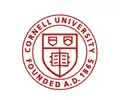Louis Albright ’63, M.S. ’65, Ph.D. ’72, a world-renowned expert in environmental engineering of agricultural buildings and a pioneer in renewable energy systems, died March 26 in Ithaca. He was 81.
After earning his degrees at Cornell and spending two years teaching at the University of California, Davis, Albright returned to join the Cornell faculty in 1974. He taught at Cornell until 2010 when he was elected professor emeritus of biological and environmental engineering.
Born Dec. 31, 1940, Albright grew up in Newfield, New York, the child of two Cornell alumni. He served in the U.S. Army from 1965 to 1968.
His research career began with predicting airflow patterns in buildings and quantifying the behavior of wall jets, which are used to improve ventilation in livestock housing such as dairy barns. Proper ventilation is critical for the health and well-being of livestock, reducing disease incidence and overheating. Albright then moved to understanding and improving environmental control in greenhouses, the work for which he is perhaps best known.
Avoiding imports
During the energy crisis of the 1970s, Albright became interested in understanding how the Northeast could grow more of its own vegetables to avoid relying so heavily on imported produce. In collaboration with the New York State Energy Research and Development Authority, Albright built research greenhouses in Ithaca and used them to develop and test procedures and strategies to grow organic vegetables like lettuce, kale, and spinach in a way that was fast, productive, and environmentally friendly.
For many years afterward, the greenhouses were used to grow vegetables for commercial sale by several ventures, including Challenge Industries. The procedures Albright developed have been adopted by growers across the Northeast to help them produce vegetables year-round in cold climates.
Francis Vanek, senior lecturer in Civil and Environmental Engineering, met Albright in 2004 when both were teaching courses on renewable energy. Albright first developed a course on renewable energy systems in the 1990s, and he was “way out ahead of his time” in doing so, said Vanek, who now teaches the course.
“That’s not something we studied in graduate school at the time and could just adapt. He built that course from scratch,” Vanek said. “That was a big contribution to create such a long-running course on renewable energy, which is now becoming more and more important, and many students want to study it.”
Books
In addition to more than 100 peer-reviewed articles and book chapters, Albright wrote two books that have become indispensable in the field of biological and environmental engineering: “Environmental Control for Animals and Plants” and a textbook, “Energy Systems Engineering,” which was co-written by Vanek. First published in 2008, the textbook is now in its fourth edition, and it has been translated into Chinese, Korean and Swedish.
Albright also owned or co-owned three commercial patents on controlling light and carbon dioxide in greenhouses to optimize plant growth. He was named a fellow of the American Society of Agricultural Engineers in 1994.
Albright was also widely recognized as a superb teacher and mentor. In 2004, his students nominated him for the Stephen H. Weiss Presidential Fellowship, which honors faculty members who have shown sustained commitment to undergraduate teaching and advising.
Chris Hogan ’04, who nominated Albright, recalled Albright urging him to engage in undergraduate research and giving him tips on approaching faculty members about working in their labs. The encouragement helped Hogan publish two peer-reviewed articles by the time he graduated, he said.
“Every year, he took the time to learn the names of all the 100-plus students in his introductory BEE 151 class,” said Hogan, now a professor of mechanical engineering at the University of Minnesota. “It is very difficult to find a professor so dedicated and so caring toward teaching undergraduates as Dr. Albright was.”
Hogan said Albright was “incredibly influential in advancing my knowledge and shaping my career goals.”
In a recorded interview, Albright described his teaching philosophy simply: “Treat your students like your children.”
He is survived by his wife, Marilyn, son Adam ’96, daughter Amy, and stepdaughters Darla and Rhonda.
For more information:
Cornell University
www.cornell.edu
